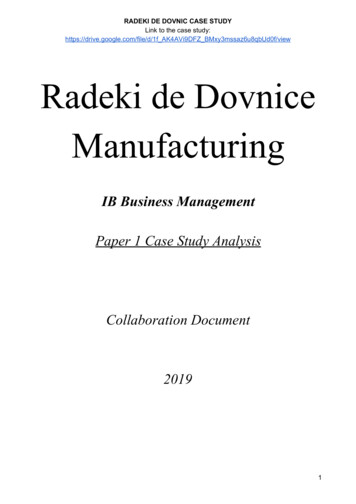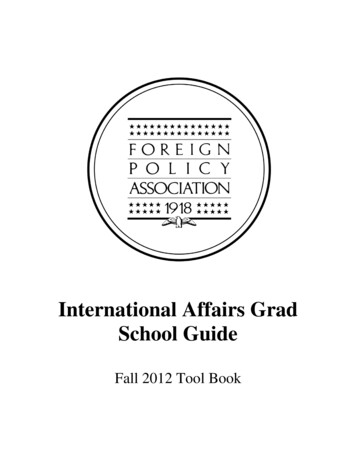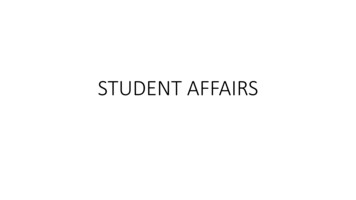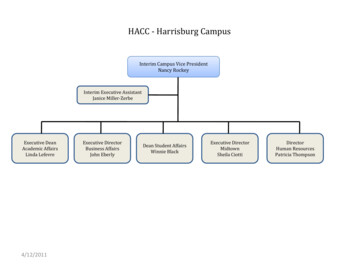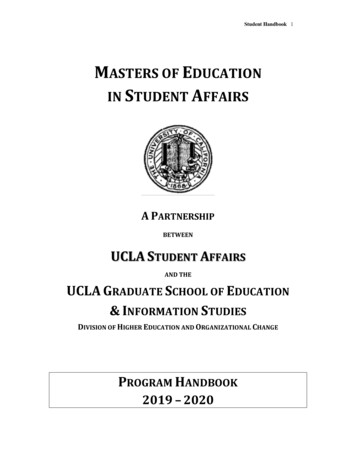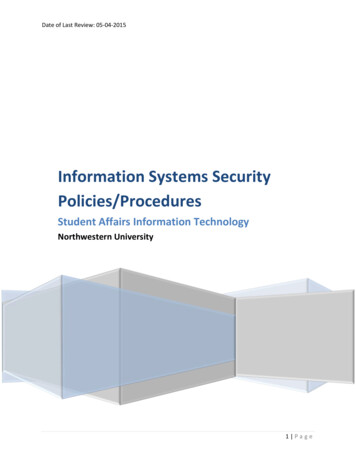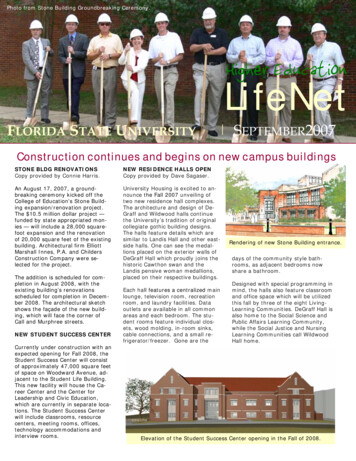
Transcription
Table of Contents 1Table of ContentsMISSION STATEMENT AND GOALS. 3STATE OF THE PROGRAM. 4Dafina-Lazarus (D-L) Stewart, Jennifer Johnson, and Pamela GragliaCURRENT JOURNAL BOARD MEMBERS AND READER BOARD. 6MANAGING EDITORS’ PERSPECTIVE. 7Isabel Villalobos-Galeana, Stephanie Cuevas, Patrick Ramirez,and Génesis Góngora BalamADVISORS’ PERSPECTIVE. 9Teresa Metzger and Karla Perez-VelezACKNOWLEDGEMENTS. 11PAST LEADERSHIP. 12Ideologies of Absence: Anti-Blackness and Inclusion Rhetoricin Student Affairs Practice. 15Dr. Dafina-Lazarus (D-L) StewartARTICLESDimensions of Doctoral Education: A Review of the Literature Review. 31Le Shorn S. BenjaminFERPA Fear or FERPA Flex: Student Affairs Practitioners’ Understandingof Federal Privacy Laws on Campus. 39Rene Couture, Jeremy Schwehm, and Valerie CoutureReligious, Secular, and Spiritual Identities: What We Knowabout the Transgender and Non-Binary Experience. 51Kate Curley and Raul A. LeonAsian American Transracial Adoptees: Identity Development in College. 61Jessica J. FryExamining Diversity in Student Affairs: An Analysisof Diversity Definitions and Supports. 69Leah HakkolaSocialized Masculinity and Its Influence on Male Foster Youth AlumniStopping-Out of College. 83Felipe D. Longoria and Corey B. RumannStudent-Athletes: Academics and Identity for Black Male College Studentsin Revenue-Generating Sports – A Literature Review. 99Gordon Maples, Nina Berger, Candace Collins, and Michelle HealeyDoes Emotional Intelligence Predict Persistence among Studentson Academic Probation?. 107Sylvia L. Mendez, Ph.D., Carrie Arnold, Ph.D., Patty Erjavec, Ph.D.,and Leona Lopez, Ph.D.
2 Journal of Student Affairs, Vol. XXVIII, 2018-2019Surviving Whiteness and White People: The Coping Strategiesof Black, Entry-Level Student Affairs Professionals. 121Robin Phelps-Ward, Ed.D. and Jeff Kenney, Ph.D.Transgender Students’ Experiences in Postsecondary Education:A Literature Review. 135Alyssa Stefanese YatesUndocumented Students, Community Colleges, and the Urgent Callfor Undocu-Competence. 145Nicholas Tapia-FuselierBuild the Pyramid: A Best Practices Literature Reviewfor Living-Learning Communities. 153Maxwell M. WagnerTo Study Abroad or Not to Study Abroad: That Is the STEM Question. 163Matthew A. Witenstein and Janel Henriksen HastingsCLASS OF 2019. 176GUIDELINES FOR MANUSCRIPT PUBLICATION. 177GRANT P. SHERWOOD FOUNDATION. 179
Mission Statement and Goals 3Colorado State UniversityJournal of Student AffairsMission StatementThe mission of the Colorado State University Journal of Student Affairs is to develop andproduce a scholarly publication which reflects current national and international educationissues and the professional interests of student affairs practitioners. GoalsThe Journal will promote scholarly work and perspectives from graduatestudents and student affairs professionals, reflecting the importance ofprofessional and academic research and writing in higher education.The Editorial Board of the Journal will offer opportunities for students todevelop editorial skills, critical thinking, and writing skills while producing aprofessional publication.
4 Journal of Student Affairs, Vol. XXVIII, 2018-2019State of the ProgramDafina-Lazarus Stewart, Ph.D.Jennifer Johnson, Ph.D.Pamela Graglia, Ph.D.This marks the 51st year of the Student Affairs in Higher Education (SAHE) program atColorado State University. The SAHE program continues to respond to the demands ofour changing profession while centering the learning and development of our students. Weextend our appreciation to faculty, staff, advisors, assistantship supervisors, and alumni whoall contribute to providing a high-quality experience for our students.We are especially happy to announce that Dr. Pamela Graglia joined the SAHE program ina new role as assistant program coordinator this summer as a non-tenure track, full-timefaculty member for SAHE and the Higher Education Leadership (HEL) Ph.D. program atCSU. Pamela is no stranger to SAHE and has been co-teaching the research class that preparesstudents to complete their portfolio, providing leadership related to curriculum changes, andadvising students for years. We are grateful that her new role will allow Pamela to contributein new and different ways to SAHE. This addition means the program is now supported bytwo full-time faculty members in addition to our dedicated scholar-practitioner faculty fromacross campus.The SAHE program maintains a strong relationship with both the Division of Student Affairsand the School of Education at Colorado State University. The Division of Student Affairscontributes roughly 240,000 in funding for graduate assistantships that support SAHEresidential students. Through support for SAHE’s full-time faculty and contributions toresidential faculty pay, the School of Education also makes a significant financial investmentin SAHE. Also, the School of Education welcomed a new Director, Dr. Susan Faircloth, lastsummer. Dr. Faircloth has provided strong support for the SAHE program so far. Her researchinterests (Indigenous education, the education of culturally and linguistically diverse studentswith special educational needs, the moral/ethical dimensions of school leadership) stronglyalign with SAHE values.Chaired by Dr. Kathy Sisneros and Dr. Pamela Graglia during 2016-2017 and taken up byD-L upon their arrival in Fall 2017, the SAHE curriculum committee finalized their visionfor the future of SAHE coursework, pedagogy, and philosophy in the fall of 2018. The newcurriculum gives students more options to explore their interest areas through electivecourses, greater access to research opportunities, and better preparation for working withthe unique needs of today’s college students. The new curriculum has been entered into theCurriculum Information Management system (CIM) and now must receive approval at manylevels of the institution. Assuming all goes well, the new curriculum will be launched for bothresidential and online SAHE students during the 2019-2020 academic year.SAHE leadership continues to have conversations with HEL leadership to brainstorm waysthat the two programs can collaborate for the mutual benefit of both programs. With D-Land Pamela already teaching in HEL, other opportunities for cross-over of faculty, advising,and resources could lead to better experiences for both Master’s and Doctoral level students.Collaboration could also create a pipeline of students between the Master’s and Ph.D.We welcomed new instructors this year to the SAHE faculty including Adam-Jon Apariciowho is co-teaching the residential Human Relations in Education course and Jerel Benton who
State of the Program 5is co-teaching the online Access and Success course focused on postsecondary opportunitiesin program practice. Although transitioning to retirement, we are excited that Kris Birnardand Oscar Felix will continue teaching for SAHE. Finally, we’d like to thank Karla Perez-Velezfor her work teaching the Introduction to Research and Program Evaluation courses. Wewish her well as she will be stepping away from teaching this year in order to focus on thecompletion of her dissertation, while continuing with her excellent service as co-advisor tothe Journal of Student Affairs board.This January, Dr. Jody Donovan, and Lance Wright, ’01 SAHE Grad, and two SAHE studentsserving in the capacity of International Field Experience Coordinators (Dani Andrews andLucy Delgado) led a group of 15 students on a trip to Spain in conjunction with their eightweek Global Perspectives in Higher Education course. The highlights of their visit includedBarcelona, Madrid, and Salamanca. In each city, a university was visited as well as seeingimportant cultural attractions.We continue to have a strong program graduating students who are prepared to enter thefield as practitioner-scholars. Our continued 100% placement rate within three months ofgraduation attests to this. SAHE continues to be the most diverse graduate program in theSchool of Education and across the university.Our ability to recruit and yield minoritized students from multiple social groups – includingPeople of Color, queer and trans students, and international students – illustrates ourdemonstrated commitment to diversity and inclusion, as well as equity and justice. It is also anindicator that these values are shared across our alumni, faculty, and assistantship supervisors.We remain committed to furthering our work in this area so that principles of equity andjustice further permeate our curricular content and instructional pedagogy as fundamentalcomponents of professional practice in student affairs.Producing a high quality SAHE journal year after year is no easy task. It requires thework of many including content and style readers, Journal editorial board members, anddedicated advisors (Karla Perez-Velez and Teresa Metzger). We’d like to express our thanksand appreciation for all who contributed to making this 28th edition of the SAHE Journal asuccess. Happy reading!
6 Journal of Student Affairs, Vol. XXVIII, 2018-2019Colorado State UniversityJournal of Student AffairsVolume XXVIII, 2018-2019Editorial BoardManaging Editor – CoordinationManaging Editor – TechnicalManaging Editor – Marketing and OutreachManaging Editor – Training and DevelopmentAssociate Editor – CoordinationAssociate Editor – TechnicalAssociate Editor – Marketing and OutreachAssociate Editor – Training and DevelopmentAdvisorAdvisorIsabel Villalobos-Galeana ’19Stephanie Cuevas ’19Génesis Góngora Balam ’19Patrick Ramirez ’19Amber Everett ’20Maria J. Matta Moreno ’20Sonia Garcia ’20Tanisha Muquit ’20Teresa MetzgerCSU University Housing,Assistant DirectorSAHE Journal Board AdvisorKarla Perez-VelezCSU University Housing,Assistant DirectorSAHE Journal Board AdvisorContributing Journal Reviewers from the SAHE ProgramStephanie ZeeDrew Thomas Ashby-KingAllis WerkemeisterAngela HoffmanJeffrey MarianoAlejandro DiazCam ElvheimKurt LooserSam BorenChelsea HapnerLindsay MasonMike SunAmy HaggardMarta RustenTo contact the Editorial Board, please call or write:Student Affairs in Higher EducationColorado State University201 Administration BuildingFort Collins, CO 80523-8004Phone: 970.491.5312Email: journal@colostate.eduThe 28th edition of the Journal is available online: www.sahe.colostate.edu
Managing Editors’ Perspective 7Managing Editors’ PerspectiveStephanie Cuevas, Managing Editor – TechnicalGénesis Góngora Balam, Managing Editor – Marketing and OutreachPatrick Ramirez, Managing Editor – Training and DevelopmentIsabel Villalobos-Galeana, Managing Editor – CoordinationThe Journal of Student Affairs is proud to present its 28th edition for publication. For 27 years,Colorado State University (CSU) graduate students have worked diligently to produce thisannual scholarly journal. This has proven to be a valuable experience for them as it enhancedtheir own critical thinking and writing skills. As a result, every edition has met the Journal’smission of promoting national and global work in higher education. This year’s edition hasauthors from a variety of backgrounds who contributed both literature reviews and originalresearch. It is our hope that for many more editions to come, the Journal of Student Affairscontinues to evolve alongside the field of student affairs and higher education.To further encourage more authors and a variety of perspectives, we collectively agreed tore-shift our publication timeline. This allowed for an efficient process in which we saw anincreased number of submissions and now more published articles compared to the recentpast editions. As we began the publishing process, we noticed an incongruence in ouremphasized value of social justice and inclusion and our usage of the term ‘blind-process.’In order to disrupt the ableist nature of the phrase, the editorial board agreed, and saw it asour responsibility, to reframe the language to ‘masked-process.’ Thus, we made the change toour websites, corrected each other through the transition, and now, have the hope that morescholars, editors, and journals in the academics would recognize the power language can havein dismantling forms of -ism’s. Lastly, we submitted our first presentation proposal for NASPAand although we were not selected, we gained valuable experience throughout that process.We are proud of these changes and are eager to see what else is in store for the Journal in theyears to come.Furthermore, we are honored to present this year’s invited article from Dr. Dafina-Lazarus (DL) Stewart, who is a full-time faculty member for the Student Affairs and Higher Education(SAHE) program at Colorado State University. We are honored to have Dr. Stewart as ourguest author this year. Not only is he giving so much to our program, but he is also providingmuch scholarship to the field of higher education. His contribution to the Journal is evenmore so special to us because Dr. Stewart begun working for the SAHE program at the sametime we begun studying in SAHE during the fall of 2017.The managing editors would like to give our utmost appreciation and gratitude to our advisors,Karla Perez-Velez and Teresa Metzger, for their hard work and continued dedication to theJournal. They have guided us through countless hours of reviewing articles and challengedus in our way of thinking around student affairs research. Without them we would not havegrown as a journal and as an editorial board.In addition, we would like to express our gratitude to Dr. Blanche Hughes, the Division ofStudent Affairs, and the Leadership Team of the SAHE Program, Dr. Dafina-Lazarus (D-L)Stewart, Dr. Jen Johnson, and Dr. Pamela Graglia for their permanent support to the Journalof Student Affairs. Their work along with the School of Education and the Leadership Teamof the Higher Education Leadership doctoral program provided us with the opportunityto attend the 43rd ASHE Conference. During our participation in the annual conference,
8 Journal of Student Affairs, Vol. XXVIII, 2018-2019we connected with researchers and learned from their work. It helped us to understand theprocess between research and publication. The conference, along with our newest boardmembers, challenged us to think deeper on the voices who get published and the voices whoare still missing in academia.We want to extend our gratitude to the authors of this year’s edition. Their dedication,inspiration, creativity, and time were fundamental. We have been fortunate enough to havethe opportunity to read their works and to further understand national and internationaltrends. Also, this edition could not have been published without the hours put in by ourreviewers. They provided both positive and critical feedback to the authors, which furtherenhanced their work.Finally, we would like to express our gratitude and deep appreciation to the Associate Editors:Maria, Sonia, Amber, and Tanisha for bringing in their enthusiasm, knowledge, critical lenses,and a fresh perspective to the board. As Managing Editors, we were challenged to rethink howwe served in the board and how to best contribute to the current knowledge base of trends instudent affairs. The Associate Editors allowed us the opportunity to leave behind a strongerlegacy at CSU, the SAHE program, and the field of higher education. We are confident thatas they transition into their roles as Managing Editors, they will continue excelling in theirpositions. As for us, we are excited for our future endeavors and will always reflect fondlyupon the experiences and skills gained through the Journal of Student Affairs.
Advisors’ Perspective 2018-2019 9Advisors’ Perspective 2018-2019The 2018-2019 Colorado State University (CSU) Student Affairs in Higher Education (SAHE)Editorial Board for the Journal of Student Affairs has brought forward an engaging Journal forstudent affairs practitioners and scholars. We believe you will enjoy reading this year’s Journalof Student Affairs and appreciate the learning and development the Journal provides this yearfor our profession.We would like to thank the SAHE Leadership Team, Dr. D-L Stewart, Dr. Pamela Graglia, Dr.Jen Johnson, as well as the School of Education for their unwavering support of the Journal andEditorial Board. Additionally, we would like to extend our gratitude to the SAHE supervisors,advisors, and faculty for without their support of the students and staff participating in theEditorial and Review Boards the work of the Journal could not be accomplished. To ColleenRodriguez and her publishing team, we thank you for your assistance in producing the CSUSAHE Journal of Student Affairs.We would also like to thank the leadership of CSU Housing and Dining Services – ChristieMathews, Director of University Housing Projects and Outreach; Laura Giles, AssociateExecutive Director; and Mari Strombom, Executive Director for the on-going support of us asthe advisors of the SAHE Journal Board.In 2018, we continued our development of scholarship in attending the 43rd AnnualConference for the Association for the Study of Higher Education (ASHE) held in Tampa,FL with a conference focus of 1968 to 2018 Envisioning the Woke Academy: Past, Present, andFuture. Our second-year students were able to connect with scholars, practitioners, and fellowgraduate students while attending ASHE in addition to having the chance to interact withcurrent CSU doctorate students, alumni, and faculty in the Higher Education and Leadership(HEL) program at the second annual CSU social hosted at the conference. It was a great timeto connect and network with a large community of CSU scholars.For our invited article, Dr. D-L Stewart engages us and the field with a thoughtful pieceentitled Ideologies of Absence: Anti-Blackness and Inclusion Rhetoric in Student Affairs Practice.Dr. Stewart states,Despite inclusion rhetoric in student affairs, anti-Blackness shapes theexperiences of Black graduate and full-time professionals, who are bothhypervisible and invisible in student affairs. Using four scenarios reflectingcomposite narratives, the author [Dr. Stewart] discusses how inclusionhides the pervasiveness of anti-Blackness in student affairs practice.Offering a new framework, the author discusses four ideologies of absence:(un)belonging, (un)safety, (in)validation, and (un)reward. These ideologiesof absence are contrasted with four ideologies of Black presence.The abstract above speaks to the ongoing narratives that black students and student affairsprofessionals experience on campus despite focused efforts on inclusion and social justicein higher education. The article goes on to discuss the impact of anti-blackness and whitesupremacy on college campuses. We are grateful for Dr. Stewart’s scholarship and forpublishing this scholarly piece within the Journal of Student Affairs.We continue to be honored in serving as the advisors to the CSU SAHE Journal Board, agroup of dedicated graduate students working towards the advancement of scholarship inSAHE through the production of a scholarly journal. We are proud of the eight students wework with and their dedication in the production of the 28th Journal of Student Affairs.
10 Journal of Student Affairs, Vol. XXVIII, 2018-2019Lastly, to the 2018-2019 SAHE Journal Board, you have strengthened the foundation of theJournal through your thoughtful conversations and we thank you for your time and criticalreflection. Each of you makes the advisor role a gratifying and educational experience.Teresa MetzgerSAHE Journal Board AdvisorKarla Perez-VelezSAHE Journal Board Advisor
Acknowledgements 11AcknowledgementsThe Editorial Board wishes to thank the following individuals for their contributions towardthe success of the 2018-2019 Journal of Student Affairs: Cole Wise, Executive Assistant for the Office of the Vice President of StudentAffairs, for their continued support and for their assistance in preparing theEditorial Board for success at ASHE 2018-19. Dr. Pamela Graglia, Assistant Professor and Assistant Program Coordinatorof the SAHE Program, Student Affairs in Higher Education master’s programfor her diligent efforts in updating and overseeing the Journal of Student Affairswebsite. Dr. D-L Stewart, SAHE Leadership Team, Professor, Student Affairs in HigherEducation master’s program for providing this edition’s guest article. Dr. Jen Johnson, SAHE Leadership Team, Assistant Director, Office of StudentLeadership, Involvement and Community Engagement for building greaterconnections between the on-campus and online students on the Journal. Karla Perez-Velez, Assistant Director for University Housing, for pushing us toconsider the future of Journals and Journal Editorial Boards to come, and herconstant dedication to our professional development as Journal Editorial Boardmembers. Teresa Metzger, Assistant Director for University Housing, for her timededicated to dedication to making this year’s Journal one of the best it’s everbeen, and her support and guidance with the overall editing and review process Colleen Rodriguez, Communications Coordinator for Communications andCreative Services, for her commitment in printing professional quality copies ofthe Journal of Student Affairs. SAHE faculty and advisors, for preparing and serving as guides to EditorialBoard members during this process. Members of the Editorial Board for dedicating a tremendous level ofprofessionalism and passion, and for their commitment to making the Journal abetter and more available publication than ever before. Contributing Journal Reviewers for their hard work and dedication to editingand analyzing articles. The authors and contributors who chose to submit articles to the 28th AnnualJournal of Student Affairs. Your research, dedication, and quality contributionsmade it possible to produce this edition. NASPA and ASHE graduate program directories for assisting the Journal ofStudent Affairs in reaching out to a broader audience of graduate students andnew professionals who wish to submit articles for publication.
12 Journal of Student Affairs, Vol. XXVIII, 2018-2019Past LeadershipAs we produce the 28th edition of the Colorado State University Journal of Student Affairs, weacknowledge those who have laid the foundation for our success.MANAGING EDITORS2017-2018Benjamin Petrie ’18, Kayla A. Tejada ’18, Kristina “KK” Miller ’182016-2017Jenny Kim ’17, S M Jafar Sadek ’17, Myvy Ngo ’17, Liz Menter ’172015-2016Matthew Dempsey ’16, LeRoy Ford ’16, Kevin Ngo ’16, Colin Watrin ’162014-2015Roberto Cruze ’15, Henry Duong ’15, Ashleigh A. Renteria ’15,Tolulope A. Taiwo ’152013-2014Christopher R. Carter ’14, Emma Hart ’14, Maria R. Marinucci ’14,Vanessa Santana ’142012-2013Jake N. Cohen ’13, Olivia Des Chenes ’13, Spencer Ellis ’13, Joseph F. Kimes’13, Mallory Perkins2011-2012Alexis M. Hendrix ’11, Anthony G. Pang ’12, Marney E. Randle ’12,Kristal D. Sawatzke ’122010-2011Tyler Cegler ’11, Jennifer David ’11, Helen Kang ’11, Joseph Kowalczyk Jr.’11, Lisa LaPoint ’112009-2010Jordan Alexander ’10, Kinsey Holloway ’10, Joe Levy ’10, Nicole Scheer ’102008-2009Kyle Carpenter ’09, Jeff Rosenberry ’09, David Vale ’092007-2008Travis Mears ’08, Neal Oliver ’08, Gretchen Streiff ’082006-2007Craig Beebe ’07, Timothy Cherney ’07, Yulisa Lin ’072005-2006Kristen Harrell ’06 Brandon Ice ’062004-2005Marci Colb ’05, Haley N. Richards ’052003-2004Ann Dawson ’042002-2003Lea Hanson ’032001-2002Jody Jessup ’022000-2001Chris Bryner ’011999-2000Greg Kish ’001998-1999Kirsten Peterson ’991997-1998Beth Yohe ’981996-1997Ray Gasser ’97, Jocelyn Lowry ’971995-1996DeEtta Jones ’96, Michael Karpinski ’961994-1995Jeremy Eaves ’95, Alicia Vik ’951993-1994Mary Frank ’94, Keith Robinder ’941992-1993Jodi Berman ’93, Brad Lau ’931991-1992Marie E. Oamek ’92
Past Leadership 13FACULTY ADVISORS2014-2019Teresa Metzger, Assistant Director for University Housing. Karla PerezVelez, Assistant Director for University Housing, Student Affairs in HigherEducation, School of Education, College of Health and Human Sciences,Colorado State University.2007-2013Oscar Felix, Associate Vice President for Enrollment and Access/Diversity;Assistant Professor Faculty, Student Affairs in Higher Education, School ofEducation, College of Health and Human Sciences, Colorado State UniversityAndrea Takemoto Reeve, former Director Academic Advancement Center;former Professor, Student Affairs in Higher Education, School of Education,College of Health and Human Sciences, Colorado State University2004-2007Jennifer Williams Molock, former Director of Black Student Services,Colorado State University2003-2006David A. McKelfresh, Executive Director of Assessment and Research;Program Chair for the SAHE Graduate Program, Colorado State University2000-2003Paul Shang, former Director of HELP/Success Center, Colorado StateUniversity1996-2000Martha Fosdick (’95), former Assistant to the Vice President for StudentAffairs, Colorado State University1991-1998Keith M. Miser, former Vice President for Student Affairs, Colorado StateUniversity
14 Journal of Student Affairs, Vol. XXVIII, 2018-2019
Ideologies of Absence: Anti-Blackness and Inclusion Rhetoric in Student Affairs Practice 15Ideologies of Absence: Anti-Blackness and InclusionRhetoric in Student Affairs PracticeD-L StewartColorado State UniversityAbstractDespite inclusion rhetoric in student affairs, anti-Blackness shapes theexperiences of Black graduate and full-time professionals, who are bothhypervisible and invisible in student affairs. Using four scenarios reflectingcomposite narratives, the author discusses how inclusion hides thepervasiveness of anti-Blackness in student affairs practice. Offering a newframework, the author discusses four ideologies of absence: (un)belonging,(un)safety, (in)validation, and (un)reward. These ideologies of absence arecontrasted with four ideologies of Black presence.Keywords: Afro-futurism, Afro-pessimism, anti-Blackness, student affairsAuthor’s NoteI wish to express my sincere appreciation to the scholars and professionals who reviewed thispaper and offered valuable feedback: Drs. Z Nicolazzo and OiYan Poon, Mx. Romeo Jackson,Ms. Shaunda Brown, and Ms. Jaelyn Coates.IDEOLOGIES OF ABSENCE:ANTI-BLACKNESS AND INCLUSION RHETORIC IN STUDENT AFFAIRSPRACTICEScene 1: Black student approaches Black graduate faculty member about assistantship climate******Black Student: I keep hearing from my supervisor that they’re getting feedbackfrom other people that I look mean and unapproachable. I don’t know what theymean by that. My supervisor told me to try smiling more.Black Faculty Member: [Immediately thinking how familiar this sounds andhow much they have been given this same message.] Hmmm. How does that makeyou feel?Black Student: It makes me feel like there’s something wrong with me. Like, I justbe sitting there at my desk doing my work or whatever. I’m minding my business youknow and so that means I’m unapproachable?! It’s like they want me to constantlybe having some stupid smile on my face all the time. I do smile when it’s warranted.I just don’t smile all the time.Black Faculty Member: [nodding] Of course.Black Student: I’m not going to shuck and jive just to be seen as professional. Isthat what it takes to be in this field? If so, maybe I made the wrong choice.Black Faculty Member: Yea, I’m thinking of Stepin Fetchit and the idea thatin order to be palatable and seen as not aggressive, Black people are expected toperform for the benefit of white people.Black Student: Yea, exactly. That’s not how I’m set up.
16 Journal of Student Affairs, Vol. XXVIII, 2018-2019Scene 2: Aftermath of 2016 presidential election; heightened racial animus on campus and inresidence halls. Black student comes to Black faculty member to debrief how they are feeling.*****Black Faculty Member: So, how’s it been going in your residence hall?Black Student: Doc it’s been rough. I’ve got residents [Students of Color, Queer,and/or Trans*] in distress. My RAs [res
Chaired by Dr. Kathy Sisneros and Dr. Pamela Graglia during 2016-2017 and taken up by D-L upon their arrival in Fall 2017, the SAHE curriculum committee finalized their vision for the future of SAHE coursework, pedagogy, and philosophy in the fall of 2018. The new


